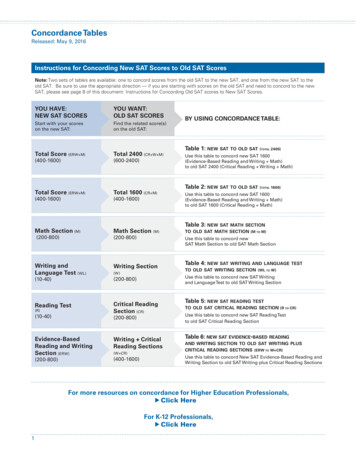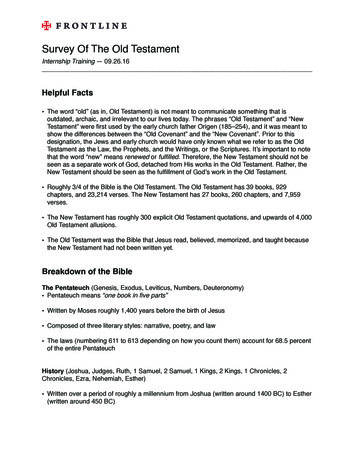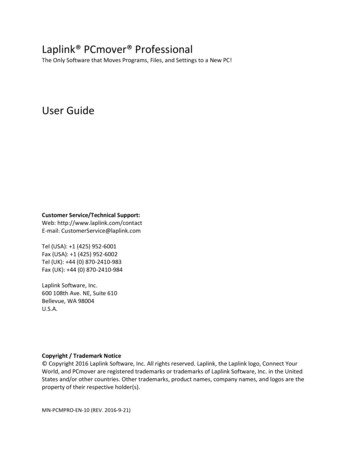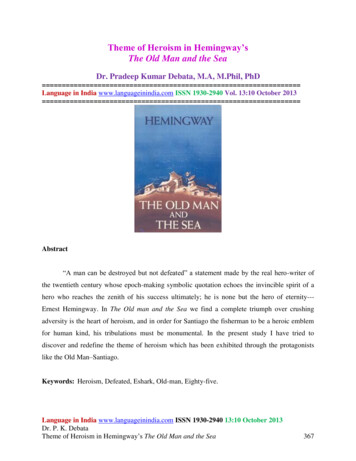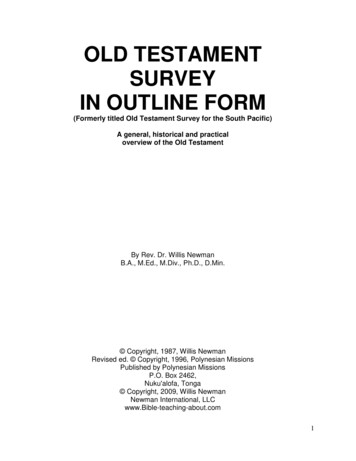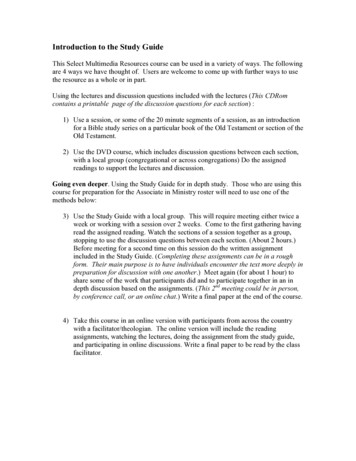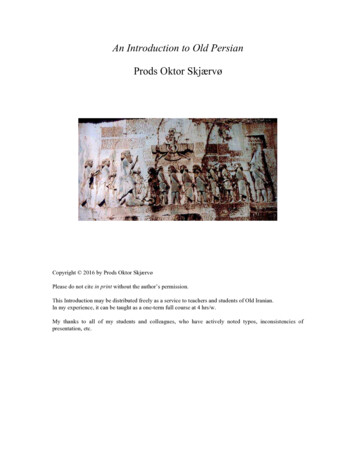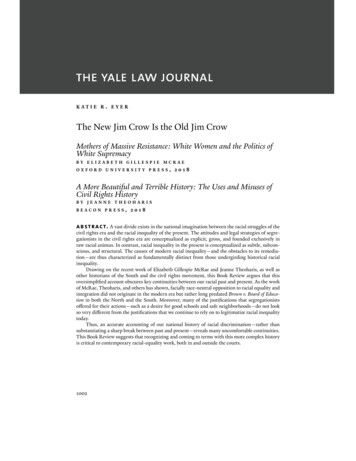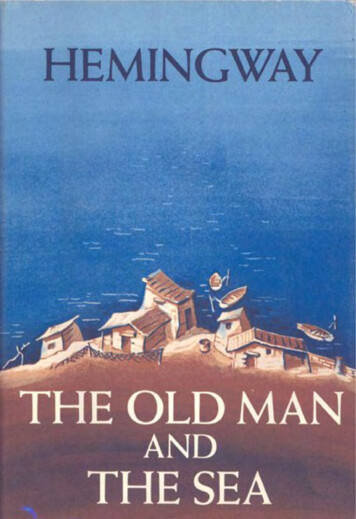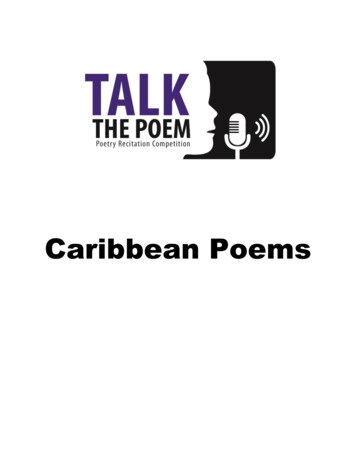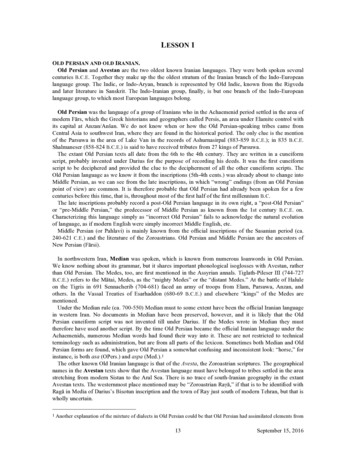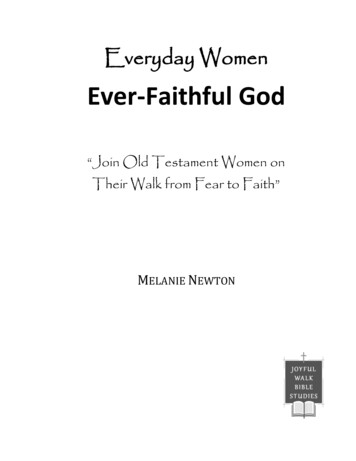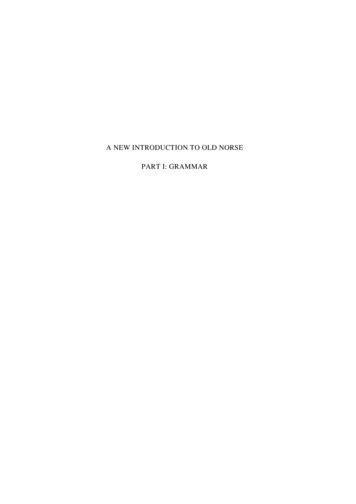
Transcription
A NEW INTRODUCTION TO OLD NORSEPART I: GRAMMAR
A NEWINTRODUCTION TOOLD NORSEPART IGRAMMARTHIRD EDITIONBYMICHAEL BARNESVIKING SOCIETY FOR NORTHERN RESEARCHUNIVERSITY COLLEGE LONDON2008
M. P. Barnes 1999/2004/2008ISBN: 978-0-903521-74-1First published 1999Reprinted with corrections and additions 2001Second edition 2004Third edition 2008Printed by Short Run Press Limited, Exeter
PrefaceThis Grammar is intended for university students with no previousknowledge of Old Norse. It covers considerably more than the essentials, however, and is suitable for study up to first degree level. Fullaccount is taken of the fact that grammatical concepts may be unfamiliar to many using the work, and all but the most basic are explained.Comparison is made with English where helpful, and a glossary ofgrammatical terms included at the end. Although it is possible to studythe Grammar on one’s own, the guidance of a tutor is strongly recommended.The bulk of the Grammar was available in draft by the time of the1998–99 session, and was tried out by several teachers at British universities. Content and presentation have benefited greatly from thecomments and suggestions of both teachers and students. I would likein particular to thank Alison Finlay, Judith Jesch and SvanhildurÓskarsdóttir, who offered many valuable insights, Peter Foote, whoread the whole work and improved it in countless ways, and finallyAnthony Faulkes, who not only commented on numerous points ofdetail but designed the layout and saw the production of the bookthrough from start to finish. Needless to say, such faults as remain aremy responsibility.Michael P. BarnesUniversity College LondonJuly 1999Preface to second editionThe necessity for a further reprint has made it possible to introduce anumber of corrections and changes, and to add a new section on pointsof syntax (3.9.9).Users will also be pleased to know that there is now a CD that canbe obtained from the Viking Society containing extracts I, II, IV, VIIB,VIII (b) and (e), IX and X from NION II read with Modern Icelandicpronunciation by Icelanders: Selected Readings from A New Introduction to Old Norse, published by The Chaucer Studio, 2003.April 2004
Preface to third editionThe book has been corrected and revised throughout, and a postscriptadded (pp. 262–3).May 2007
ContentsAbbreviations and Symbols . xii1.Introduction1.1 The aim of the Grammar . 11.2 What is Old Norse? . 11.3 Old Norse and modern English . 21.4 Pronunciation . 31.5 Orthography . 41.6 General advice to the student . 52.Pronunciation and Orthography2.1 Old Norse . 82.1.1 Pure vowels . 82.1.1 Exercise . 92.1.2 Diphthongs . 92.1.2 Exercise . 102.1.3 Consonants . 102.1.3 Exercise . 122.1.4 Syllables . 132.1.4 Exercise . 132.2 Modern Icelandic . 142.2.1 Vowels . 142.2.1 Exercise . 162.2.2 Consonants . 162.2.2 Exercise . 202.2.3 Syllables . 202.2.4 The epenthetic vowel . 202.2.3/2.2.4 Exercise . 213.Morphology and Syntax3.1 Noun inflexions and their function . 223.1.1 Number . 223.1.2 Case . 223.1.3 Gender . 273.1.1/3.1.2/3.1.3 Exercise . 283.1.4 Basic noun inflexions . 283.1.4 Exercise . 31
3.1.53.1.53.1.6Examples of noun usage . 31Exercise . 37Difficulties in recognising noun inflexionsand ways of overcoming them . 373.1.6 Exercise . 393.1.7 Important variations in noun inflexion . 393.1.7.1 Labial mutation . 393.1.7.1 Exercise . 413.1.7.2 Front mutation . 413.1.7.2 Exercise . 443.1.7.3 Breaking . 443.1.7.4 Deviations from the basic endings . 453.1.7.5 Minor irregularities . 453.1.7.3/3.1.7.4/3.1.7.5 Exercise . 463.1.8 Examples of noun inflexion . 473.1.8 Exercise . 533.1.9 The suffixed definite article . 563.1.9 Exercise . 583.2 Pronoun inflexions and their function . 603.2.1 Personal pronouns: form . 613.2.2 Demonstrative pronouns: form . 633.2.3 Indefinite pronouns: form . 653.2.4 Negative pronouns: form . 663.2.5 Interrogative and distributive pronouns: form . 673.2.1/3.2.2/3.2.3/3.2.4/3.2.5 Exercise . 683.2.6 Examples of pronoun usage . 683.2.6 Exercise . 763.3 Adjective inflexions and their function . 773.3.1 Number, case and gender . 773.3.2 Definiteness . 783.3.3 Degree (comparison) . 793.3.1/3.3.2/3.3.3 Exercise . 793.3.4 Basic adjective inflexions . 803.3.4 Exercise . 843.3.5 The free-standing definite article . 843.3.5 Exercise . 863.3.6 Examples of adjective usage . 873.3.6 Exercise . 95
3.3.7Difficulties in recognising adjective inflexionsand ways of overcoming them . 963.3.7 Exercise . 973.3.8 Important variations in adjective inflexion . 983.3.8.1 Labial mutation . 983.3.8.1 Exercise . 993.3.8.2 Front mutation . 993.3.8.3 Suppletive forms . 1003.3.8.4 Deviations from the basic endings . 1013.3.8.5 Minor irregularities . 1023.3.8.2/3.3.8.3/3.3.8.4/3.3.8.5 Exercise . 1033.3.9 Examples of adjective inflexion . 1043.3.9 Exercise . 1113.4 Numerals . 1153.4.1 The numerals and their inflexions . 1153.4.1 Exercise . 1193.4.2 Examples of numeral usage . 1203.4.2 Exercise . 1233.5 Adverbs . 1243.5.1 Adverb formation . 1243.5.2 Inflexion for degree . 1253.5.3 Examples of adverb usage . 1273.5.1/3.5.2/3.5.3 Exercise . 1293.5.4 Adverbs and adverbials . 1303.6 Verb inflexions and their function . 1313.6.1 Person and number . 1313.6.2 Tense . 1323.6.3 Mood . 1343.6.4 Voice . 1353.6.1/3.6.2/3.6.3/3.6.4 Exercise . 1363.6.5 Basic verb inflexions . 1373.6.5.1 Endings . 1373.6.5.1 Exercise . 1393.6.5.2 Vowel alternations . 1403.6.5.2 Exercise . 1433.6.5.3 The -sk form . 1443.6.5.3 Exercise . 146
3.6.6 Finite and non-finite forms; principal parts . 1463.6.6 Exercise . 1523.6.7 Preterite presents and other irregular verbs . 1523.6.7 Exercise . 1553.6.8 Examples of verb usage . 1553.6.8 Exercise . 1643.6.9 Important variations in verb inflexion . 1643.6.9.1 Phonological variation . 1653.6.9.2 Morphological variation . 1683.6.9.3 Idiosyncratic variation . 1693.6.9.1/3.6.9.2/3.6.9.3 Exercise . 1713.6.10 Examples of verb inflexion . 1713.6.10 Exercise . 1773.7 Prepositions . 1813.7.1 Prepositions triggering the accusative . 1823.7.2 Prepositions triggering the genitive . 1843.7.3 Prepositions triggering the dative . 1853.7.4 Prepositions triggering the accusativeand dative . 1893.7.5 Prepositions triggering the accusative andgenitive . 1963.7.6 Preposition triggering the accusative,genitive and dative . 1973.7.7 Residual remarks . 1973.7 Exercise . 1993.8 Conjunctions . 2003.8.1 Coordinating conjunctions . 2023.8.2 Subordinating conjunctions . 2043.8.2.1 The particle er . 2043.8.2.2 The particle at . 2123.8.2.3 Interrogative pronouns and adverbs . 2153.8.2.4 Other adverbial sentence introducers . 2183.8 Exercise . 2213.9 Residual points of syntax . 2233.9.1 Sentence word-order . 2233.9.1 Exercise . 228
3.9.2 Word-order in noun phrases . 2283.9.2 Exercise . 2303.9.3 Impersonal constructions . 2303.9.3 Exercise . 2363.9.4 Accusative and infinitive . 2363.9.4 Exercise . 2403.9.5 Omissions . 2403.9.5.1 Objects . 2413.9.5.2 vera . 2413.9.5.3 Verbs of motion . 2433.9.5 Exercise . 2433.9.6 Points of nominal syntax . 2443.9.6.1 Idiomatic uses of personal pronouns andpossessive adjectives . 2443.9.6.2 The genitive and dative of respect . 2463.9.6 Exercise . 2483.9.7 Points of verbal syntax . 2483.9.7.1 The perfect and past perfect . 2483.9.7.2 The passive . 2513.9.7.3 The ‘dative absolute’ . 2533.9.7.4 Present participles expressing potentialityor obligation . 2543.9.7 Exercise . 2553.9.8 Points of syntax affecting more than onetype of phrase . 2563.9.8.1 Adjectival and adverbial complements . 2563.9.8.2 Agreement between subject, verb andsubject complement . 2573.9.8.3 -sk verb forms and ‘preposition adverbs’ . 2593.9.8 Exercise . 2603.9.9 Adverbial ok . 261A postscript on ‘impersonal constructions’ . 262References to linguistic terms explained in the Grammar . 264Select glossary of linguistic terms not explained in the Grammar . 266Bibliography . 270
Abbreviations and imp.indic.inf.interrog.m.n.NION I–IIInom.NPONpass.pl.pos.pp.pres.refl.REFL. POSS.sg.subj.sup.vb.* uterA New Introduction to Old Norse I: Grammar;II: Reader; III: Glossary and Index of Namesnominativenoun phraseOld Norsepassivepluralpositivepast participlepresentreflexivereflexive possessivesingularsubject; subjunctivesuperlativeverbreconstructed form; ungrammatical sentencedevelops todevelops fromzero ending
1 Introduction1.1 The aim of the GrammarFrom the point of view of the student, many existing grammars of OldNorse suffer from two major defects. First, they are largely constructedon historical principles and thus contain detail about earlier stages ofthe language and linguistic development, little of which is of directuse to someone seeking to acquire a reading knowledge of Old Norse.Second, they assume a level of linguistic sophistication which theschool system no longer cultivates, and so leave unexplained manythings which to the modern student are opaque.The present Grammar has been written with one aim only: to facilitate the learning of Old Norse for as wide a range of students as possible.It therefore eschews historical digressions except where they throwessential light on the workings of the language, and an attempt is madeto explain all but the most basic ideas, concepts and terms on theirfirst appearance or, failing that, in the Select Glossary (pp. 264–6).The emphasis throughout is pedagogical, and the work thus representsnot so much a re-think of Old Norse grammar as a re-think of the ways inwhich the basics of Old Norse may be best presented to the learner.1.2 What is Old Norse?The term ‘Old Norse’ has been used in various ways. For some it is abroad concept covering the language of Denmark, Norway and Sweden, as well as Iceland and the other Scandinavian colonies, throughout the Viking Age (c. 750–1050) and the early and high Middle Ages(c. 1050–1350). At the other extreme it has been taken to mean onlythe Old Norwegian of the early and high Middle Ages. In the presentcontext it is used principally to signify the language of Norway in theperiod c. 750–1350 (after which Norwegian changes considerably) andof Iceland from the settlement (c. 870) to the Reformation (c. 1550 —a date that sets a cultural rather than a linguistic boundary). Known inmodern Icelandic as norræna, in Norwegian as norrønt and in Englishsometimes as Old West Norse, this type of speech is a western variety
2A New Introduction to Old Norseof Scandinavian. Scandinavian itself represents the northern branchof the Germanic group of languages, whose western branch includesDutch, English and German.As a result of Viking-Age expansion, Old Norse (in the sense justdefined), which had its origins in Norway, came to be spoken in suchwidely different places as Faroe, Greenland and Ireland, but it wasonly in Iceland and Norway — especially the former — that a significant scribal culture developed, and it is upon manuscripts in Icelandicand Norwegian written with the roman alphabet that our knowledgeof Old Norse is chiefly based. The earliest Icelandic and Norwegianvernacular manuscripts that have survived are dated to c. 1150, but thebulk are from the thirteenth and fourteenth centuries, and many Icelandic manuscripts are later still. For insights into Old Norse prior to1150 we are dependent on runic inscriptions, bits and pieces preservedin foreign language sources, and verse composed in the Viking Agebut recorded in medieval manuscripts.Although Icelandic c. 870–1550 and Norwegian c. 750–1350 arehere given the designation ‘Old Norse’, it would of course be wrongto think of this language as entirely uniform, without variation in timeor space. The form of Scandinavian spoken in Norway around 750differed in a number of important respects from that spoken around1350, and by the latter date the Norwegian carried to Iceland by theoriginal settlers had begun to diverge from the mother tongue. Nevertheless, in the period c. 1150–1350, when the great medieval literatureof Iceland and Norway was created, there existed an essential unity oflanguage in the western Scandinavian world, and it is on that unitythat the present Grammar is based.1.3 Old Norse and modern EnglishA major difference between Old Norse and modern English is that OldNorse is a much more highly inflected language. Modern English stillhas certain inflexions, by which is meant that words change their formaccording to their function in a sentence (e.g. she came, I saw her; sg.cat, pl. cats; pres. run, past ran), but Old Norse has a far greater number.In English the function of a word can often be deduced from its position in relation to other words. We understand:
Introduction3Olav saw the old womanto mean that Olav was the one who saw and the old woman the onewho was seen because Olav precedes saw. Reverse the order and theopposite applies. In a corresponding Old Norse sentence it would beperfectly possible for the order to be reversed without a change inmeaning. Everything would depend on the inflexions. Thus:Óláfr sá konu flá ina gƒmluandKonu flá ina gƒmlu sá Óláfrboth mean ‘Óláfr saw the old woman’, because the forms Óláfr andkonu flá ina gƒmlu are unchanged. If we wish the sentence to mean‘the old woman saw Óláfr’, we must alter the forms of the words so thatÓláfr becomes Óláf and konu flá ina gƒmlu becomes kona sú in gamla.It is obvious, therefore, that from the very start the student willhave to pay the closest attention to inflexions. Failure to do so willresult in the regular misunderstanding of Old Norse texts.1.4 PronunciationEven in the case of dead languages, pronunciation is of some importance. If students cannot translate letters on the page into sounds, itbecomes well-nigh impossible for them to discuss the language theyare trying to learn. Furthermore, for those without an exclusively visualmemory, the association of image and sound is a valuable aid tolearning.The pronunciation of Old Norse, like that of Latin, varies from country to country and sometimes from teacher to teacher. In the Englishspeaking world a widespread practice is to adopt modern Icelandicpronunciation. Although it is often claimed there is little differencebetween modern Icelandic and Old Norse (and this is true enough asregards the inflexional system and the basic vocabulary), the pronunciation has changed a great deal since the first centuries of the settle-
4A New Introduction to Old Norsement of Iceland. The adoption of modern pronunciation, while puttingthe learner at some distance from the speech of those who wrote theliterature s/he is reading, nevertheless has the great advantage thatone can in effect listen to native speakers reproducing the language,and thus learn to read aloud not only with fluency but with naturalintonation (patterns of voice pitch). For those whose chief interest isOld Norse literature, modern Icelandic pronunciation has much torecommend it. The pure language student, on the other hand, will findthe modern pronunciation frustrating: not only does it obscure the relationship between several common sounds — and thus also betweenlarge numbers of words or word-forms — it can render meaninglessrules involving syllable length (especially important in poetry). In thepresent work, therefore, an outline is given of the pronunciation bothof Old Norse and of modern Icelandic. For the former we can rely to aconsiderable extent on a twelfth-century work, the so-called FirstGrammatical Treatise (ed. Haugen 1972; Hreinn Benediktsson 1972),which discusses in some detail the vowel and consonant sounds of theIcelandic of that age. This, together with what we can deduce fromspelling, historical comparisons and modern pronunciation (Icelandicand different varieties of Norwegian) means that guidance on theessentials of Old Norse pronunciation during the golden years of literaryproduction can be offered with reasonable confidence.1.5 OrthographyThe scribes who wrote Old Norse did not conform to standardisedrules of spelling, any more than their counterparts in medieval England and elsewhere. They wrote words more or less as they had beentrained to do at the scriptorium where they studied, although they mightalso be influenced by forms in an exemplar from which they werecopying — and occasionally by their own pronunciation. The result isthat most Old Norse words appear in manuscripts in a variety of spellings. In order to facilitate the making of grammars, dictionaries andtext books, therefore, and to help the learner, modern scholars haveadopted a normalised orthography for Old Norse. Some editions ofOld Norse writings, designed more for the philologist and linguistthan the literary reader, follow closely the spelling of the manuscript
Introduction5or manuscripts on which they are based, while in others the normalisedorthography may be adapted to bring it into greater harmony with thatof the manuscript source. This last practice means that normalisationof Old Norse does not conform to an immutable standard. Even betweengrammars, text books and dictionaries a degree of variation can befound. The present Grammar, for example, does not always acknowledge the lengthening of a, o, ƒ, u which took place in twelfth–thirteenthcentury Icelandic before various consonant clusters beginning withl (e.g. hjalpa hjálpa, folk fólk, hjalmr hjálmr), although suchlengthening is generally indicated in Parts II and III (Reader andGlossary and Index of Names) of A New Introduction to Old Norse.The conventions adopted here are in the main those found in E. V.Gordon, An Introduction to Old Norse (1957), which deviates little fromusage in many of the major editions and dictionaries. It should be noted,however, that the two dictionaries most used by English-speakingstudents, Richard Cleasby and Gudbrand Vigfusson, An IcelandicEnglish Dictionary (1957) and Geir Zoëga, A Concise Dictionary ofOld Icelandic (1910), make a few concessions to modern Icelandicorthography (for which see, for example, Stefán Einarsson 1945, 1–31).1.6 General advice to the studentThe present Grammar is intended primarily for university students,and how it is used will be determined largely by individual tutors.Nevertheless, it may be helpful to both students and staff, and to anyone studying on their own, to offer outline guidance on the learningprocess — not least because it is the author’s understanding of howOld Norse can most effectively be learnt that has determined the structure of the Grammar. With the emphasis on learning, the followingremarks are addressed direct to the student.Decide at the outset which pronunciation to adopt, and stick to it.Vacillating between rival pronunciations is confusing. Having decided,read through the relevant part of section 2. Do not attempt to learn allthe rules of pronunciation at once. Read words, then phrases, thenwhole sentences aloud, referring to the rules as and when necessary. Ifyou adopt modern Icelandic pronunciation, try to obtain recordings ofnative speech.
6A New Introduction to Old NorseYour learning of morphology and syntax should initially be concentrated on the basics of nouns, pronouns, adjectives and verbs. Theseare the most highly inflected word classes in Old Norse, and the mostcentral to the understanding of what you are reading.Begin with the nouns. If you are uncertain about concepts like‘number’, ‘case’ and ‘gender’, read sub-sections 3.1.1, 3.1.2 and 3.1.3and do the accompanying exercise. Now learn the endings given in3.1.4, noting the patterns. If you find this material too abstract, youcan compare the endings with those of the actual nouns listed in 3.1.8.There is much greater variety of inflexion there, though, and that mayconfuse rather than help you in the early stages. The noun paradigmsof 3.1.8 are meant primarily for reference as the learning proceeds.When you are satisfied you have mastered everything in 3.1.4, do theexercise. Next, study in detail the examples of noun usage given in3.1.5, paying particular attention to the accompanying notes. This isyour introduction to the basics of Old Norse syntax, and you shouldbe prepared to spend a fair amount of time on it. When you have assimilated all the information in 3.1.5, do the exercise. Then read through3.1.6 and answer the questions at the end of it. Now try the exercise in3.1.8, using a dictionary or the Glossary in NION III and the nounparadigms listed in this sub-section. Do not worry if you do not get allthe answers right straight away; this exercise is part of the learningprocess as well as a test of knowledge. Sub-section 3.1.7 on the mostimportant variations in noun inflexion is not intended to be read at onego and learnt, but is there to be consulted as and when problems arise.You should, however, familiarise yourself with the fundamentals oflabial mutation as soon as possible.Following the nouns, section 3.1.9 on the suffixed definite articleshould be studied and the accompanying exercise completed.Now go on to section 3.2. Learn the pronoun paradigms set out here,noting the correspondences between them, and follow this by doingthe exercise covering 3.2.1–3.2.5. Next, study in detail the examplesof pronoun usage given in 3.2.6, paying due attention to the accompanying notes. When you have assimilated all the information in 3.2.6,do the exercise.Section 3.3 on adjectives follows largely the pattern of 3.1 on nouns,and the various items should be tackled in the same order and manner(with 3.3.8 for consultation as necessary, and the paradigms in 3.3.9
Introduction7for reference). Note, however, that the free-standing definite article istreated immediately after basic adjective inflexions; it should be studied before you go on to the examples of adjective usage, where thisform of the article occurs quite widely.From adjectives proceed to section 3.6 on verbs. Work through subsections 3.6.1 to 3.6.8 in the order they appear (3.6.1 to 3.6.4 may beomitted if you are familiar with the concepts discussed). 3.6.9 is forconsultation as necessary. The paradigms in 3.6.10 are for reference;the exercise at the end of this section is, however, an essential task.Having assimilated the basic forms and functions of Old Norse nouns,pronouns, adjectives and verbs, you should go on to tackle numerals (3.4)and adverbs (3.5). When studying the numerals, note in particular similarities with other inflexional types and the various idiomatic usagesdetailed in both 3.4.1 and 3.4.2. Regarding the adverbs, pay particularattention to adverb formation and inflexion for degree (3.5.1, 3.5.2).As soon as practicable, you should begin to read an Old Norse text.It is recommende
tate the learning of Old Norse for as wide a range of students as possible. It therefore eschews historical digressions except where they throw essential light on the workings of the language, and an attempt is made to explain all but the most basic ideas, concepts and terms on theirFile Size: 726KBPage Count: 282Explore furtherThe 10 Best Norse Mythology Books - Norse Mythology for .norse-mythology.orgA short history of the English language Linguaenglish blogwww.lingualearnenglish.com(PDF) Oxford Collocations Dictionary for Students of Englishwww.researchgate.net(PDF) Brief History of the English languagewww.researchgate.netThe Old Norse Language and How to Learn It - Norse .norse-mythology.orgRecommended to you b
